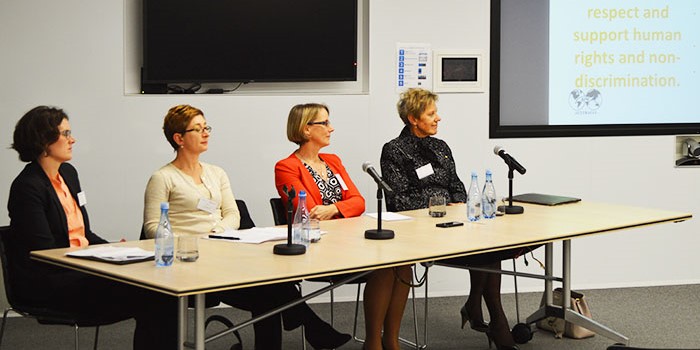Women supporting women to resolve gender inequality in the legal profession
"We have an awfully long way to go", Chief Justice Diana Bryant AO, Family Court of Australia, said when discussing the 35.6 per cent pay gap between women and men's salaries in the legal industry.

Speaking at the Business & Professional Women's event 'Empowering Women in the Legal System: An Equal Pay Day Event' last week, a panel consisting of Chief Justice Bryant, Alex Cuthbertson, a partner at Allens, Kirsten Adams, convenor of Victorian Women Lawyers and Laura Douglas, lawyer with Justitia, all Melbourne Law School alumna, agreed that while strides have been made towards gender equality, there is still much to be done. They emphasised the importance of women supporting women in the legal industry; "it is the role of women in leadership positions to talk", Chief Justice Bryant said.
Chief Justice Bryant said that she was not convinced all that much progress had been made since she was admitted to practice in the 1970s. Chief Justice Bryant said the same problems and culture of the male-dominated legal profession are still prevalent today.
Women comprise 63 per cent of the people admitted to the legal profession today, but make up less than 10 per cent of senior appointments. This has been the trend for several decades with women constituting around 60 per cent of law graduates in Australia but with men representing the majority of lawyers in private practices, senior positions in law firms and at the Independent Bar.
The Law Council of Australia's February 2014 National Attrition and Re-Engagement Study (NARS) Report, revealed that 47 per cent of women reported that they had been subjected to gender-based discrimination, compared with 13 per cent of men.
Whilst no panel member was able to give a definitive answer on why this trend continues to persist, they suggested some practical steps that law firms and individuals can take to address the inequality within the legal profession.
1. Speak up
According to Ms Adams, a female's experience in law can come down to what matters they are allocated to work on, saying if they are not allocated high profile work, they will not progress in their career. Women need to ask for these roles and for high calibre matters; "this is the reality", Ms Cuthbertson said.
Ms Douglas however suggested that both males and females should be more vocal about flexible working arrangements and that this was the only way to change the climate in which we currently work.
Ms Adams also advocated for young female lawyers to speak up when workplace behaviour was not acceptable. She hoped that in doing so, this new generation of young lawyers would encourage change in attitudes, behaviours and practices. Whether this is a possible approach for young women to do in the current competitive job market is however another issue.
2. Implement positive policies
Chief Justice Bryant discussed the need to support firms who have innovative and new ways of addressing the inequality between males and females in the profession and are looking to promote a positive workplace culture for females. Chief Justice Bryant recounted that the Family Court bench is comprised of 50 per cent females and that a number of judges had young children at school. These thoughts were echoed by the other panel members who advocated for policies that promote an acceptance of familial responsibilities and supports flexibility in working arrangements.
Ms Adams explained that a large commercial law firm had recently reviewed their policy of determining the salaries of partners and where they had noticed a difference between women and men's salaries, such salaries had been adjusted; with one female thereafter received an adjustment pay rise of $150,000. However, she queried how these policies would progress in the future.
Ms Cuthbertson said that the recent shift in the culture of firms to implement policies that promote lawyers through merit rather than years of service (which can ignore time off for maternity leave), "is a start", these policies still do not go far enough to encourage and promote women in the workplace to take up senior positions and that there is still much work to be done.
3. Be a strong role model, mentor and advocate for other women.
Ms Cuthbertson discussed the importance of females in senior positions acting as role models and supporting women around them. She described her own experience in the workforce as a junior lawyer and the huge impact on her career in having two strong female partners and role models who were vocal advocates of the females in her group.All panel members encouraged women in senior positions to take on mentoring positions and act as positive role models to support their female colleagues in navigating their position within the legal industry.